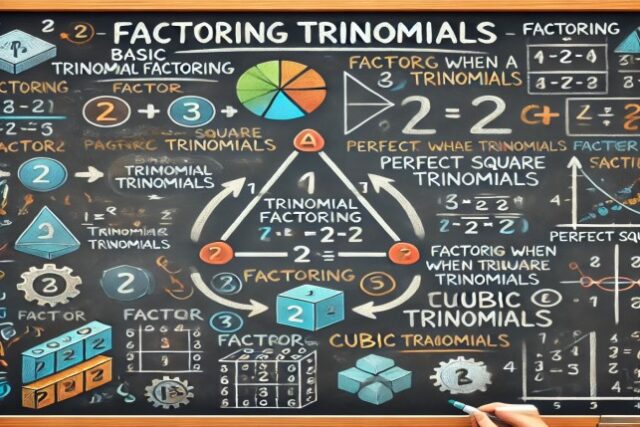Factoring trinomials is a foundational skill in algebra that helps you simplify expressions, solve equations, and understand the behavior of mathematical functions. Whether you’re a student tackling algebra for the first time or brushing up on advanced concepts, knowing how to factor trinomials will deepen your understanding of algebraic principles and improve your problem-solving skills. In this comprehensive guide, we’ll explore methods to factor trinomials, focusing on different scenarios, including cases where the leading coefficient a≠1a \neq 1a=1, perfect square trinomials, and cubic trinomials.
Table of Contents
ToggleWhat is a Trinomial?
A trinomial is a polynomial with three terms. It typically appears in the form:
ax2+bx+cax^2 + bx + cax2+bx+c
where:
- aaa, bbb, and ccc are constants,
- xxx is the variable.
Factoring involves breaking down this trinomial into simpler expressions that can multiply back to the original equation. Mastering this process opens up new ways to approach algebraic equations and inequalities.
1. How to Factor Simple Trinomials (When a=1a = 1a=1)
Let’s start with the most basic form of a trinomial where the leading coefficient aaa is equal to 1. The standard form looks like this:
x2+bx+cx^2 + bx + cx2+bx+c
To factor such a trinomial, we need to find two numbers that:
- Multiply to give ccc,
- Add up to give bbb.
Example:
Consider the trinomial:
x2+7x+12x^2 + 7x + 12x2+7x+12
- Identify the constants: Here, b=7b = 7b=7 and c=12c = 12c=12.
- Find two numbers that multiply to 12 and add to 7. The numbers 3 and 4 work since: 3×4=12and3+4=73 \times 4 = 12 \quad \text{and} \quad 3 + 4 = 73×4=12and3+4=7
- Rewrite the trinomial as: (x+3)(x+4)(x + 3)(x + 4)(x+3)(x+4)
To confirm, expand (x+3)(x+4)(x + 3)(x + 4)(x+3)(x+4) and you’ll get back x2+7x+12x^2 + 7x + 12x2+7x+12.
2. How to Factor Trinomials When a≠1a \neq 1a=1
When the leading coefficient aaa is not equal to 1, the process is a bit more complex. Here, you’ll use the AC method (also known as factoring by grouping).
Steps for Factoring When a≠1a \neq 1a=1:
- Multiply aaa and ccc.
- Find two numbers that multiply to a×ca \times ca×c and add up to bbb.
- Rewrite the middle term using the two numbers found.
- Factor by grouping.
Example:
Factor 2×2+7x+32x^2 + 7x + 32x2+7x+3.
- Multiply aaa and ccc: 2×3=62 \times 3 = 62×3=6.
- Find two numbers that multiply to 6 and add up to 7. The numbers 6 and 1 work because: 6×1=6and6+1=76 \times 1 = 6 \quad \text{and} \quad 6 + 1 = 76×1=6and6+1=7
- Rewrite the expression: 2×2+6x+1x+32x^2 + 6x + 1x + 32x2+6x+1x+3
- Group terms and factor: (2×2+6x)+(1x+3)=2x(x+3)+1(x+3)(2x^2 + 6x) + (1x + 3) = 2x(x + 3) + 1(x + 3)(2x2+6x)+(1x+3)=2x(x+3)+1(x+3)
- Factor out the common binomial: (2x+1)(x+3)(2x + 1)(x + 3)(2x+1)(x+3)
The factors of 2×2+7x+32x^2 + 7x + 32x2+7x+3 are (2x+1)(x+3)(2x + 1)(x + 3)(2x+1)(x+3).
3. How to Factor Perfect Square Trinomials
A perfect square trinomial takes the form:
a2+2ab+b2a^2 + 2ab + b^2a2+2ab+b2
or
a2−2ab+b2a^2 – 2ab + b^2a2−2ab+b2
These trinomials result from squaring a binomial and can be factored easily once identified.
Example:
Factor x2+10x+25x^2 + 10x + 25x2+10x+25.
- Recognize the pattern: The first term is x2x^2x2, and the last term, 25, is 525^252.
- Check the middle term: 10x=2⋅x⋅510x = 2 \cdot x \cdot 510x=2⋅x⋅5, so it matches the pattern.
- Write as a squared binomial: (x+5)2(x + 5)^2(x+5)2
Expanding (x+5)2(x + 5)^2(x+5)2 returns the original trinomial, confirming the factorization.
Example with Negative Middle Term:
Factor x2−6x+9x^2 – 6x + 9x2−6x+9.
- Recognize the pattern: The first term is x2x^2x2, and the last term, 9, is 323^232.
- The middle term is −6x=−2⋅x⋅3-6x = -2 \cdot x \cdot 3−6x=−2⋅x⋅3.
- Write as: (x−3)2(x – 3)^2(x−3)2
This matches the form for a perfect square trinomial.
4. How to Factor Cubic Trinomials
Cubic trinomials have three terms with the highest degree of three. These are less common but important in more advanced algebra. Factoring cubic trinomials can require trial and error or more advanced techniques, such as synthetic division.
A typical cubic trinomial might look like:
ax3+bx2+cx+dax^3 + bx^2 + cx + dax3+bx2+cx+d
Example: Factor x3−6×2+11x−6x^3 – 6x^2 + 11x – 6x3−6x2+11x−6
- Look for possible rational roots: Use the Rational Root Theorem to test possible factors of the constant term divided by the leading coefficient.
- Perform synthetic division to check if any of the roots provide a remainder of 0.
For x3−6×2+11x−6x^3 – 6x^2 + 11x – 6x3−6x2+11x−6:
- Using synthetic division, we find that x=1x = 1x=1 is a root.
- Rewrite the expression as: (x−1)(x2−5x+6)(x – 1)(x^2 – 5x + 6)(x−1)(x2−5x+6)
- Factor the quadratic term: x2−5x+6=(x−2)(x−3)x^2 – 5x + 6 = (x – 2)(x – 3)x2−5x+6=(x−2)(x−3)
- Combine factors: (x−1)(x−2)(x−3)(x – 1)(x – 2)(x – 3)(x−1)(x−2)(x−3)
Thus, the fully factored form of x3−6×2+11x−6x^3 – 6x^2 + 11x – 6x3−6x2+11x−6 is (x−1)(x−2)(x−3)(x – 1)(x – 2)(x – 3)(x−1)(x−2)(x−3).
5. Special Cases and Tips
- Check for GCF: Always check if there’s a greatest common factor (GCF) before beginning. This can simplify the trinomial and make factoring easier.
- Prime Trinomials: Some trinomials cannot be factored further over the set of real numbers. For example, x2+x+1x^2 + x + 1x2+x+1 has no real factors, as its discriminant is negative.
- Practice with Different Forms: Solving different types of trinomials is crucial to mastery. Practice factoring trinomials with various values of aaa, bbb, and ccc.
Conclusion
Mastering how to factor trinomials—whether simple, with a leading coefficient other than one, perfect square, or cubic—is an essential skill in algebra. By following the steps and examples in this guide, you’ll develop the intuition and skill needed to tackle a wide range of trinomial expressions.



MOST COMMENTED
Business
World Politics News: Geopolitical Analysis for Strategic Decision-Makers
Business
World News Headlines: Global Developments Impacting Business and Policy
Business
Top World News Stories: What’s Shaping the Globe Today?
World News
Global News Updates: Stay Informed with Key Events
Crypto
“Current World News: Major Stories of 2025”
Crypto
Be1crypto.com Markets is a cryptocurrency trading platform designed to cater to both novice and experienced traders. It offers a user-friendly interface, a wide range of supported cryptocurrencies, advanced trading tools, and robust security measures. The platform aims to provide a seamless trading experience, allowing users to diversify their portfolios and engage in various trading activities.
World News
Chrisley Knows Best Daughter Dies: Unraveling the Truth Behind the Rumors